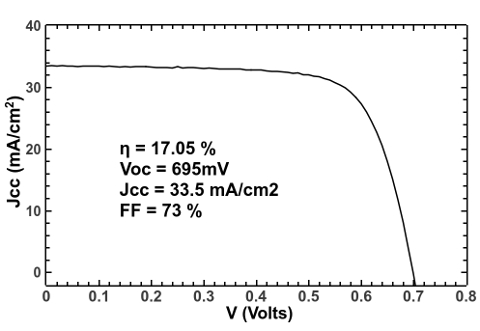Rechercher
Accueil > La Recherche > Axes & Equipes > Physique Appliquée > Chalcogénures : Photovoltaïque et 2D
CIGS based photovoltaic structures
publié le , mis à jour le
Although the theoretical maximal efficiencies should be obtained for a bandgap of 1.4 eV (according to the Shockley Queisser limit), the best results worldwide are obtained on cells with a bandgap of 1.2 eV (record efficiency in 2016 : 22.6%). This demonstrate that although the results for CIGS are on par with those for the best silicon cells, there is a lot of room for improvements. This calls for (a better) understanding of the physical mechanisms involved in a CIGS cell.
In our team, we typically grow cells with efficiencies of 17%, as shown in the picture below.

Such cell is made of a stack of materials :
– a glass substrate (soda lime glass SLG)
– molybdenum back contact, deposited by RF magnetron sputtering
– CuInGaSe2 (CIGS) p-type layer (deposited by co-evaporation)
– CdS n-type layer, grown by Chemical bath deposition (CBD)
– undoped ZnO, (RF sputtering)
– aluminum doped ZnO, (RF sputtering)
This is illustrated in the graphic below, where a Scanning Electron Microscopy (SEM) image of the cross section of a cell is shown.
— image a ajouter —
The main material in the cell (the absorber) is typically 2µm in thickness, and its bandgap can be adjusted by playing with the gallium content between 1 eV (no gallium - CIS) and 1.7 eV with 100% gallium (no indium - CGS).
As seen in the SEM image above, the material is polycristalline and there is an ongoing debate on the role of grains and grain boundaries on the cell performances.
Our work involves a loop between growth of samples, physical studies such as :
– Scanning electron and Atomic force microscopy
– Electrical characterization by I(V) under illumination, EQE, C-V profiling, Hall effect
– X-ray diffraction
– Optical studies (absorption, reflectivity, photoluminescence, time-resolved)
The team member most involved are :
Olivier BRIOT
Wilfried DESRAT
Matthieu MORET
Antoine TIBERJ








